

Essay on Rabindranath Tagore in English [500+ Words]
Essay on Rabindranath Tagore: Rabindranath Tagore was a great Indian poet. Furthermore, he was also a philosopher, patriot, painter, and humanist. In this article, you are going to read an essay on Rabindranath Tagore in English (500+ words). This essay will be helpful for students from class 1 to class 12. So, let’s begin.
Biographical Sketch of Rabindranath Tagore
| Name | Rabindranath Tagore |
| Date of Birth | May 7, 1861 |
| Place of Birth | Jorasanko, Kolkata |
| Father’s Name | Debendranath Tagore |
| Mother’s Name | Sarada Devi |
| Family | Very rich, cultured, zamindar family |
| Spouse | Mrinalini Devi |
| Pen Name | Bhanu Singha |
| Profession | Poet, writer, composer, philosopher, painter |
| Notable works | Gitanjali, Gora, Amar Sonar Bangla, Ghare Bahire etc. |
| Award | Nobel Prize (1913) for Gitanjali |
| Founded | Viswa Bharati & Shantiniketan |
| Death | 7th August 1941 |
Rabindranath Tagore: Essay
Introduction:.
Rabindranath Tagore was a phenomenon in the literary firmament not only of Bengal, but of India. Rarely has human civilisation been blessed with such a versatile genius. The soul of a nation expresses itself through him. Such was Valmiki in ancient India, Homer in Greece, Virgil in Rome, Dante in Italy, Goethe in Germany. Rabindranath is, in the words of Dr. Radhakrishnan, ‘the greatest figure in modern R Indian Renaissance’.
Early Life & Education:
Rabindranath was born on May 7, 1861 at Jorasanko, Kolkata. He was the youngest son of Maharshi Debendranath Tagore and Sarada Devi. He had a great dislike for schooling of the orthodox kind. His schools-The Oriental Seminary and the Calcutta Normal School-could not detain him for long. In 1871, he was sent to England to study. He was in Brighton School for some time. But he could. not complete his education there and returned home.
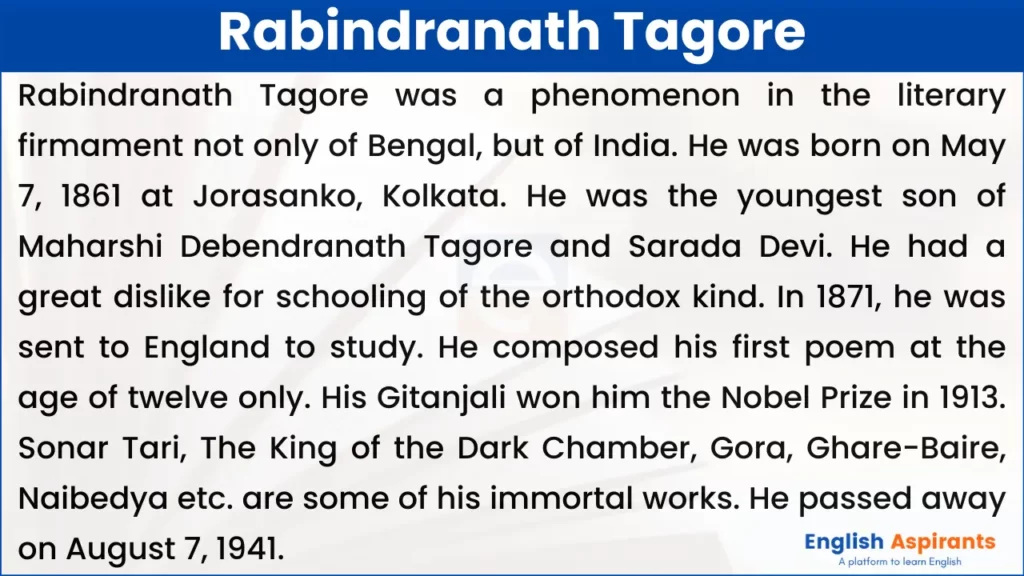
Also Read: Paragraph on Rabindranath Tagore
Literary Works:
Rabindranath was the doyen of Bengali’s cultural arena even in his early life. He composed his first poem at the age of twelve only. For nearly seventy years since then, this prolific genius penned poems, essays, dramas, short stories, and novels which attained the highest degree of splendour.
His Gitanjali won him the Nobel Prize in 1913. At once, the German scholars called him the ‘World Poet.’ Western poets like WB Yeats praised the sublime beauty of his poems. Many of his other works have been translated into a number of languages. Among his works, Balaka contains the greatest of his poems. Chitrangada is a fine lyrical drama. Sonar Tari is a great lyric in Bengali. The King of the Dark Chamber, Gora, Ghare-Baire, Naibedya etc. are some of his immortal works. His The Religion of Man is a monument of literary achievement.
Other Works:
Rabindranath expressed human moods, longings, love, joys, and sorrows in all their variations. He embellished, elevated and lighted up every aspect of Bengali literature. He created a new age in the history of Bengali literature which was known as the age of Rabindranath. But a writer’s life of an ivory tower was not for him.
Tagore had guided the Adi Brahmo Samaj for some time. He also edited the Bharati and Bangadarshana-the two Bengali magazines. He was also associated with the Bangiya Sahitya Parishad.
The partition of Bengal brought him out in to the streets. Rabindranath gave up his knighthood in protest against the Jallianwalla bagh massacre. He set up a school at Santiniketan to implement his own ideas about education. He passed away on August 7, 1941.
Conclusion:
Rabindranath is beyond praise, criticism, beyond comparison. One should bow to this radiant genius, the Gurudev of Mahatma Gandhi. He gives us inspiration in. our weakness, hope in our despair, solace in our sorrow, and light in our darkness.
Read More: 1. Essay on Mother Teresa 2. APJ Abdul Kalam Essay in English 3. Essay on Swami Vivekananda
Related Posts
Apj abdul kalam essay in english | 100, 200, 300, 500 words, blood donation essay in english | 150, 200, 300 words, my mother essay in english 10 lines [5 sets], essay on mother teresa in english for students [300 words], leave a comment cancel reply.
Your email address will not be published. Required fields are marked *
Save my name, email, and website in this browser for the next time I comment.
Rabindranath Tagore Essay for Students and Children
500+ words essay on rabindranath tagore.
Essay on Rabindranath Tagore: Rabindranath Tagore was a legendary Indian poet. Furthermore, he was also a great philosopher , patriot , painter, and humanist. People often made use of the word Gurudev with regard to him. This exceptional personality was born on the 7th of May in 1861 at Calcutta. His early education took place at home by a variety of teachers. Also, through this education, he got knowledge of many subjects. His higher education took place in England. Above all, Rabindranath Tagore began writing poems from a very young age.

Works of Rabindranath Tagore
Rabindranath Tagore began to write drama from sixteen years of age. At the age of twenty, Rabindranath Tagore wrote original dramatic piece Valmiki Pratibha. Most noteworthy, Rabindranath Tagore works focused on feelings and not on action. In 1890 he wrote another drama work Visarjan. Visarjan is probably the best drama work of Rabindranath Tagore.
Similarly, from the age of sixteen Rabindranath Tagore began to write short stories. His first short story was Bhikarini. Most noteworthy, he is the founder of the Bengali-language short story genre. Tagore certainly wrote numerous stories from 1891 to 1895. Also, stories from this period form the collection of Galpaguchchha. It is a big collection of 84 stories.
Rabindranath Tagore was certainly in touch with novels as well. He wrote eight notable novels. Furthermore, he wrote four novellas.

Rabindranath Tagore was certainly not short on songs. The man enjoys the reputation of writing a mighty 2230 songs. The popular name in usage is rabindrasangit, which refers to Tagore’s songs. His songs certainly reflect Indian culture . His famous song Amar Shonar Bangla is the national anthem of Bangladesh. Above all, he wrote the national anthem of India Jana Gana Mana.
Rabindranath Tagore also had excellent skills in drawing and painting. Probably, Rabindranath Tagore was red-green color blind. Due to this, his artworks contain strange color themes.
Get the huge list of more than 500 Essay Topics and Ideas
Rabindranath Tagore’s contribution to politics
Rabindranath Tagore was active in politics. He was in total support of Indian nationalists. Furthermore, he was in opposition to British rule . His work Manast contains his political views. He also wrote a number of patriotic songs. Rabindranath Tagore increased the motivation for Indian independence. He wrote some works for patriotism. There was great love among the masses for such works. Even Mahatma Gandhi showed his favor for these works.
Most noteworthy, Rabindranath Tagore did renunciation of his knighthood. Furthermore, he took this step to protest the Jallianwala Bagh massacre in 1919.
In conclusion, Rabindranath was a patriotic Indian. He was certainly a man of many talents. His contribution to Literature, arts, music, and politics is brilliant.
Essay Topics on Famous Leaders
- Mahatma Gandhi
- APJ Abdul Kalam
- Jawaharlal Nehru
- Swami Vivekananda
- Mother Teresa
- Rabindranath Tagore
- Sardar Vallabhbhai Patel
- Subhash Chandra Bose
- Abraham Lincoln
- Martin Luther King
Customize your course in 30 seconds
Which class are you in.

- Travelling Essay
- Picnic Essay
- Our Country Essay
- My Parents Essay
- Essay on Favourite Personality
- Essay on Memorable Day of My Life
- Essay on Knowledge is Power
- Essay on Gurpurab
- Essay on My Favourite Season
- Essay on Types of Sports
Leave a Reply Cancel reply
Your email address will not be published. Required fields are marked *
Download the App

Biography Online

Rabindranath Tagore
Poet, writer and humanitarian, Rabindranath Tagore was the first Indian to be awarded the Nobel Prize for Literature and he played a key role in the renaissance of modern India. Tagore is most widely known for his poetry, but he was also an accomplished author of novels, short stories, plays and articles. He took an active interest in a widespread range of social, cultural and artistic endeavours. He has been described as one of the first Twentieth Century’s global man.
“So I repeat we never can have a true view of man unless we have a love for him. Civilisation must be judged and prized, not by the amount of power it has developed, but by how much it has evolved and given expression to, by its laws and institutions, the love of humanity.”
Sadhana: The Realisation of Life, (1916)
Short Biography Rabindranath Tagore
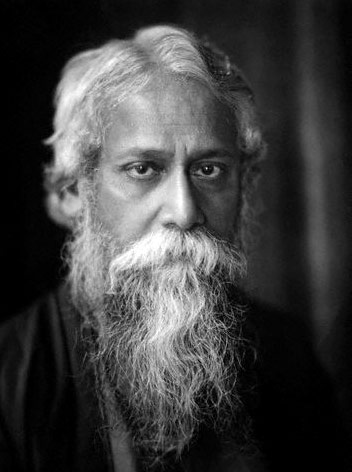
Rabindranath began writing from an early age and impressed with his free-flowing style and spontaneous compositions. He mostly rejected formal schooling; he spent much time being taught at home. In 1878 he travelled to England and sought to study law at University College, London, but he left before finishing the degree.
After returning to India, in 1901, Tagore moved to Shantiniketan to found an ashram which became his focal point for writing and his view on schooling. He chose the name for the ashram – Shantiniketan meaning ‘Abode of Peace.’
“Love is the ultimate meaning of everything around us. It is not a mere sentiment; it is truth; it is the joy that is at the root of all creation.”
– Tagore, Sādhanā : The Realisation of Life (1916)
Friendship with Gandhi
Tagore was firm friends with Gandhi and admired him very much. But, despite this friendship, he could be critical of his views. For example, he disagreed with Gandhi’s views on Swaraj protests and upbraided Gandhi when Gandhi claimed an earthquake was ‘divine retribution for the mistreatment of Dalits in India.’ Yet despite the frequent divergence of opinions, they could admire each other. When Gandhi went on a fast unto death, it was Tagor who was able to persuade Gandhi to give up his fast and look after his health.

Nobel Prize for Literature 1913
In 1913, Tagore was awarded the Nobel Prize for literature for his work ‘ Gitanjali ‘ This made his writings internationally known and his fame spread throughout the world.
“My debts are large, my failures great, my shame secret and heavy; yet I come to ask for my good, I quake in fear lest my prayer be granted.” – Gitanjali
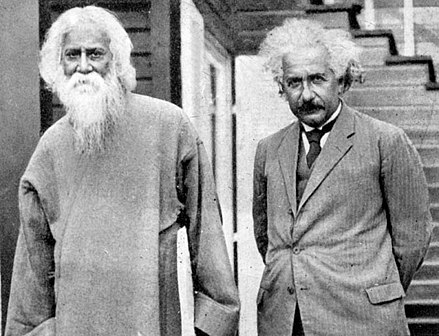
Rabindranath Tagore with Einstein
This gave Tagore the opportunity to travel extensively giving lectures and recitals in many different countries. He also became acquainted with many of the leading cultural contemporaries of the day; this included W.B.Yeats, George Bernard Shaw , Romain Rolland, Robert Frost and Albert Einstein .
Tagore had a great love for nature and many of his poems invoke the simple beauties of the natural world. For Tagore, his religion could be found in the wonders and mysteries of nature – as much as in temples and sacred books.
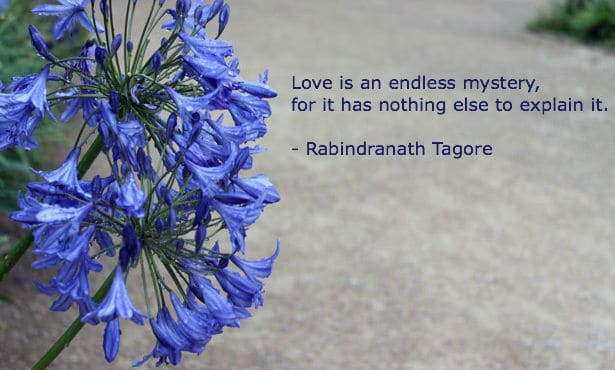
Tagore was a prolific composer of music. He composed over 2,000 songs which have been popularised and sung widely across Bengal. Like his literature, he broke away from classical constraints to offer a great emotive and spiritual appeal. Tagore is unique for being the official composer for the national anthem of two countries – India’s Jana Gana Mana and Bangladesh’s Amar Shonar Bangla .
Tagore was an opponent of British imperialism, though he also felt Indians had a duty to improve their self-education; he said that British rule was partly due to the state India had fallen into. In particular, he was very denigrating about India’s obsession with caste.
‘the ultimate truth in man is not in his intellect or his possessions; it is in his illumination of mind, in his extension of sympathy across all barriers of caste and colour, in his recognition of the world, not merely as a storehouse of power, but as a habitation of man’s spirit, with its eternal music of beauty and its inner light of the divine presence.’ – Tagore, The Poet’s Religion’ in Creative Unity (1922) [ 1 ]
In 1919, Tagore returned his knighthood in protest at the Jallianwala Bagh Massacre, in which many peaceful Indian protesters were killed.
Tagore was a polymath, and towards the end of his life he took up art and also pursued an interest in science. Tagore was also very much an internationalist, criticising nationalism, though also writing songs and articles in support of the general principle of the Indian independence movement.
“Patriotism cannot be our final spiritual shelter; my refuge is humanity. I will not buy glass for the price of diamonds, and I will never allow patriotism to triumph over humanity as long as I live. “
– Rabindranath Tagore
Tagore view on Religion
Tagore had mixed views on religion. He was brought up in a traditional Hindu family and taught to pray and meditate from an early age. He remembers the peace of mind he developed from chanting the Gayatri Mantra, but at the same time was detached from the more formalistic aspects of religion. He tended to see religion as not scriptures and places of worship but the life we lead. As he explained:
“My religion is my life – it is growing with my growth – it has never been grafted on me from outside.” ~ Tagore to Robert Bridges, 8 July 1914.
He was keen to avoid any fanaticism and saw the strength of his own Hindu religion as its ability to see more than one path to the goal. His life-long aspiration was to see a harmony of religions flourish in India – not from mere tolerance but an appreciation of the different merits other religions had.
‘The Idea of freedom to which India aspired was based upon realization of spiritual unity…India’s great achievement, which is still stored deep within her heart, is waiting to unite within itself Hindu, Moslem, Buddhist and Christian, not by force, not by the apathy of resignation, but in the harmony of active cooperation.’ ~ Tagore in Berlin, 1921.
However, he was also critical of the Hindu caste system.
Tagore’s poetry frequently hint at a mystical view of the world.
“In this playhouse of infinite forms I have had my play, and here have I caught sight of him that is formless.” – Gitanjali “The human soul is on its journey from the law to love, from discipline to liberation, from the moral plane to the spiritual.” Sādhanā : The Realisation of Life (1916)
Tagore died on 7th August 1941, after a long and painful illness, aged 80. He died in his family home.
Citation: Pettinger, Tejvan . “ Rabindranath Tagore ”, Oxford, UK www.biographyonline.net , 1st Jun. 2009. Last updated 1 March 2019.
Stories From Tagore
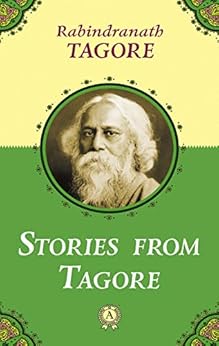
Stories From Tagore at Amazon
The Essential Tagore

The Essential Tagore at Amazon
Related pages

External Links
- Short poems of Rabindranath Tagore
- Tagore Bio at Nobel.org
Rabindranath Tagore
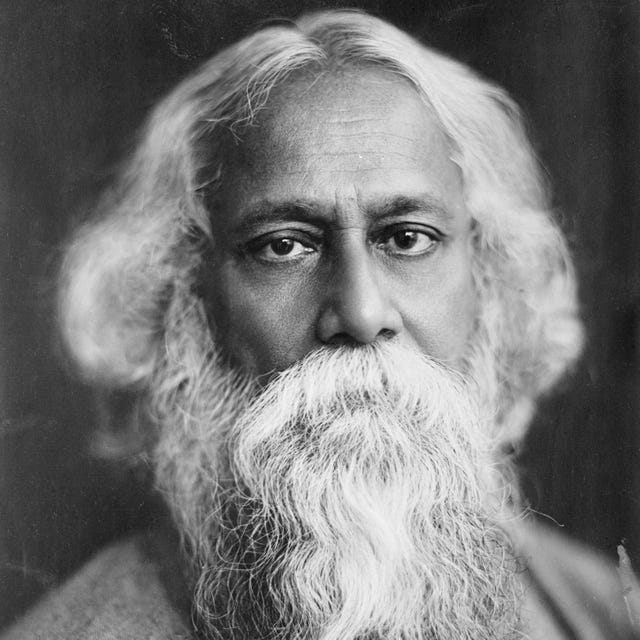
Rabindranath Tagore was a Bengali poet, novelist and painter best known for being the first non-European to be awarded the Nobel Prize for Literature in 1913 with his book Gitanjali, Song Offerings . He was highly influential in introducing Indian culture to the West and is generally regarded as the outstanding creative artist of modern India. He was hailed by W.B Yeats and André Gide.
QUICK FACTS
- Name: Rabindranath Tagore
- Gender: Male
- Best Known For: Rabindranath Tagore was a Bengali poet, novelist and painter best known for being the first non-European to be awarded the Nobel Prize for Literature in 1913.
- Writing and Publishing
- Journalism and Nonfiction
- Fiction and Poetry
- Nacionalities
- Bangladeshi (Bangladesh)
CITATION INFORMATION
- Article Title: Rabindranath Tagore Biography
- Author: Biography.com Editors
- Website Name: The Biography.com website
- Url: https://www.biography.com/authors-writers/rabindranath-tagore
- Access Date:
- Publisher: A&E; Television Networks
- Last Updated: June 24, 2021
- Original Published Date: April 2, 2014
Watch Next .css-16toot1:after{background-color:#262626;color:#fff;margin-left:1.8rem;margin-top:1.25rem;width:1.5rem;height:0.063rem;content:'';display:-webkit-box;display:-webkit-flex;display:-ms-flexbox;display:flex;}

Famous Painters
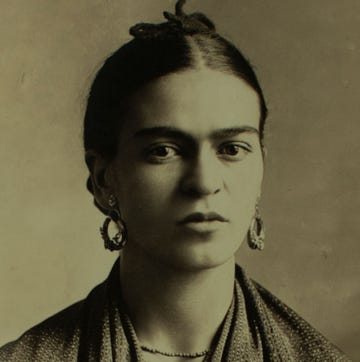
Jean-Michel Basquiat

Georgia O'Keeffe

11 Notable Artists from the Harlem Renaissance

Fernando Botero

Gustav Klimt

The Surreal Romance of Salvador and Gala Dalí

Salvador Dalí

Rabindranath Tagore
Date of Birth: May 7, 1861
Place of Birth: Calcutta, British India
Date of Death: August 7, 1941
Place of Death: Calcutta, British India
Profession: Writer, song composer, playwright, essayist, painter
Spouse: Mrinalini Devi
Children: Renuka Tagore, Shamindranath Tagore, Meera Tagore, Rathindranath Tagore and Madhurilata Tagore
Father: Debendranath Tagore
Mother: Sarada Devi
Award: Nobel Prize in Literature (1913)
Rabindranath Tagore, who composed the National Anthem of India and won the Nobel Prize for Literature, was a multitalented personality in every sense. He was a Bengali poet, Brahmo Samaj philosopher, visual artist, playwright, novelist, painter and a composer. He was also a cultural reformer who modified Bengali art by rebuffing the strictures that confined it within the sphere of classical Indian forms. Though he was a polymath, his literary works alone are enough to place him in the elite list of all-time greats. Even today, Rabindranath Tagore is often remembered for his poetic songs, which are both spiritual and mercurial. He was one of those great minds, ahead of his time, and that is exactly why his meeting with Albert Einstein is considered as a clash between science and spirituality. Tagore was keen in spreading his ideologies to the rest of the world and hence embarked on a world tour, lecturing in countries like Japan and the United States. Soon, his works were admired by people of various countries and he eventually became the first non-European to win a Nobel Prize. Apart from Jana Gana Mana (the National Anthem of India), his composition ‘Amar Shonar Bangla’ was adopted as the National Anthem of Bangladesh and the National Anthem of Sri Lanka was inspired by one of his works.
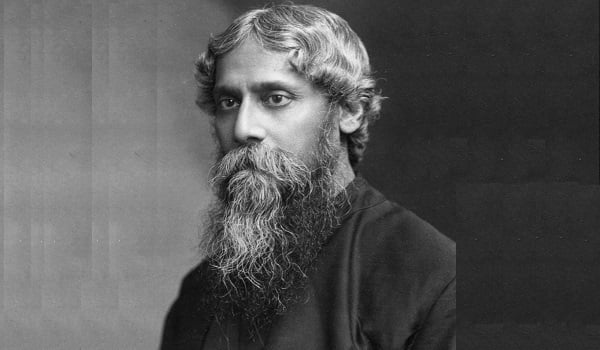
Childhood and Early Life
Rabindranath Tagore was born on 7th May 1861 to Debendranath Tagore and Sarada Devi in the Jorasanko mansion (the ancestral home of the Tagore family) in Calcutta. He was the youngest son among thirteen children. Though the Tagore family had many members, he was mostly raised by servants and maids as he lost his mother while he was still very young and with his father being an extensive traveler. At a very young age, Rabindranath Tagore was part of the Bengal renaissance, which his family took active participation in. He was also a child prodigy as he started penning down poems at the age of 8. He also started composing art works at a tender age and by the age of sixteen he had started publishing poems under the pseudonym Bhanusimha. He also wrote the short story, ‘Bhikharini’ in 1877 and the poem collection, ‘Sandhya Sangit’ in 1882.
He drew inspiration by reading the classical poetry of Kalidasa and started coming up with classical poems of his own. Some of his other influences and inspirations came from his brothers and sisters. While Dwijendranath, his elder brother, was a poet and philosopher, Satyendranath, another brother of his, was in a highly respectable position. His sister Swarnakumari was a well-known novelist. Tagore was largely home-schooled and was trained by his siblings in the field of gymnastics, martial arts, art, anatomy, literature, history and mathematics among various other subjects. In 1873, he accompanied his father and toured the country for many months. During this journey, he accumulated knowledge on several subjects. His stay at Amritsar paved the way for him to learn about Sikhism, an experience which he would later on use to pen down as many as six poems and many articles on the religion.
Rabindranath Tagore’s traditional education began in Brighton, East Sussex, England, at a public school. He was sent to England in the year 1878 as his father wanted him to become a barrister. He was later joined by some of his relatives like his nephew, niece and sister-in-law in order to support him during his stay in England. Rabindranath had always despised formal education and thus showed no interest in learning from his school. He was later on enrolled at the University College in London, where he was asked to learn law. But he once again dropped out and learned several works of Shakespeare on his own. After learning the essence of English, Irish and Scottish literature and music, he returned to India and married Mrinalini Devi when she was just 10 years old.
Establishment of Santiniketan
Rabindranath’s father had bought a huge stretch of land in Santiniketan. With an idea of establishing an experimental school in his father’s property, he shifted base to Santiniketan in 1901 and founded an ashram there. It was a prayer hall with marble flooring and was named ‘The Mandir.’ The classes there were held under trees and followed the traditional Guru-Shishya method of teaching. Rabindranath Tagore hoped that the revival of this ancient method of teaching would prove beneficial when compared to the modernized method. Unfortunately, his wife and two of his children died during their stay in Santiniketan and this left Rabindranath distraught. In the meantime, his works started growing more and more popular amongst the Bengali as well as the foreign readers. This eventually gained him recognition all over the world and in 1913 Rabindranath Tagore was awarded the prestigious Nobel Prize in Literature, becoming Asia's first Nobel laureate.
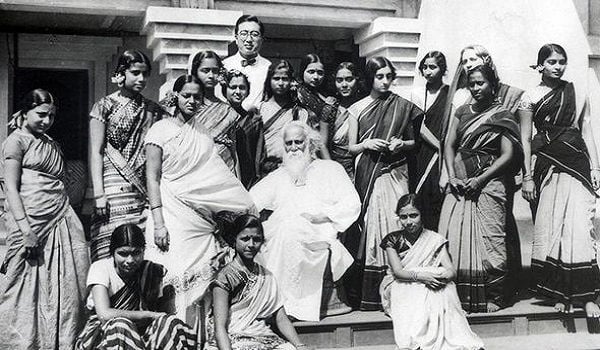
The World Tour
Since Rabindranath Tagore believed in the concept of one world, he set out on a world tour, in an attempt to spread his ideologies. He also took along with him, his translated works, which caught the attention of many legendary poets. He also lectured in countries like the United States and Japan. Soon after, Tagore found himself visiting places like Mexico, Singapore and Rome, where he met national leaders and important personalities including the likes of Einstein and Mussolini. In 1927, he embarked on a Southeast Asian tour and inspired many with his wisdom and literary works. Tagore also used this opportunity to discuss with many world leaders, the issues between Indians and the English. Though his initial aim was to put an end to nationalism, Rabindranath over a period of time realized that nationalism was mightier than his ideology, and hence developed further hatred towards it. By the end of it all, he had visited as many as thirty countries spread over five continents.
Literary Works
During his lifetime, Rabindranath Tagore wrote several poems, novels and short stories. Though he started writing at a very young age, his desire to produce more number of literary works only enhanced post the death of his wife and children. Some of his literary works are mentioned below:
- Short stories – Tagore began to write short stories when he was only a teen. He started his writing career with ‘Bhikharini’. During the initial stage of his career, his stories reflected the surroundings in which he grew. He also made sure to incorporate social issues and problems of the poor man in his stories. He also wrote about the downside of Hindu marriages and several other customs that were part of the country’s tradition back then. Some of his famous short stories include ‘Kabuliwala’, ‘Kshudita Pashan’, ‘Atottju’, ‘Haimanti’ and ‘Musalmanir Golpo’ among many other stories.
- Novels – It is said that among his works, his novels are mostly under-appreciated. One of the reasons for this could be his unique style of narrating a story, which is still difficult to comprehend by contemporary readers, let alone the readers of his time. His works spoke about the impending dangers of nationalism among other relevant social evils. His novel ‘Shesher Kobita’ narrated its story through poems and rhythmic passages of the main protagonist. He also gave a satirical element to it by making his characters take jibes at an outdated poet named Rabindranath Tagore! Other famous novels of his include ‘Noukadubi’, ‘Gora’, ‘Chaturanga’, ‘Ghare Baire’ and ‘Jogajog’.
- Poems – Rabindranath drew inspiration from ancient poets like Kabir and Ramprasad Sen and thus his poetry is often compared to the 15th and 16th Century works of classical poets. By infusing his own style of writing, he made people to take note of not only his works but also the works of ancient Indian poets. Interestingly, he penned down a poem in 1893 and addressed a future poet through his work. He urged the yet to be born poet to remember Tagore and his works while reading the poem. Some of his best works include ‘Balaka’, ‘Purobi’, ‘Sonar Tori’ and ‘Gitanjali’.
Tagore’s Stint as an Actor
Tagore wrote many dramas, based on Indian mythology and contemporary social issues. He began his drama works along with his brother when he was only a teen. When he was 20 years old, he not only did pen the drama ‘Valmiki Pratibha’, but also played the titular character. The drama was based on the legendary dacoit Valmiki, who later reforms and pens down one of the two Indian epics – Ramayana.
Tagore the Artist
Rabindranath Tagore took up drawing and painting when he was around sixty years old. His paintings were displayed at exhibitions organized throughout Europe. The style of Tagore had certain peculiarities in aesthetics and coloring schemes, which distinguished it from those of other artists. He was also influenced by the craftwork of the Malanggan people, belonging to the northern New Ireland. He was also influenced by Haida carvings from the west coast of Canada and woodcuts by Max Pechstein. The National Gallery of Modern Art in New Delhi houses as many as 102 art works of Tagore.
Political Views
Though Tagore denounced nationalism, he also vouched for the Indian independence through some of his politically charged songs. He also supported Indian nationalists and publicly criticized European imperialism. He also criticized the education system that was forced upon India by the English. In 1915, he received knighthood from the British Crown, which he later renounced citing the massacre held at Jallianwala Bagh. He said that the knighthood meant nothing to him when the British failed to even consider his fellow Indians as humans.
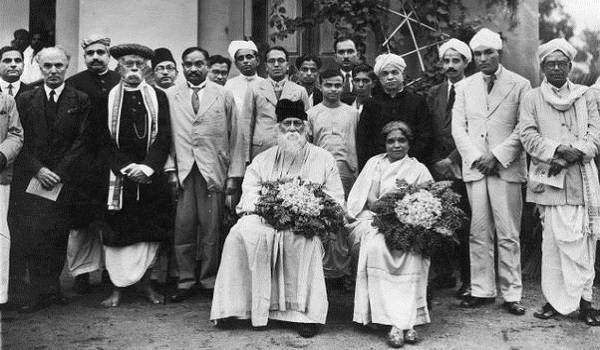
Image source: http://blog.gyanlab.com
Adaptations of Tagore’s Works
Many of his novels and short stories were made into films by the renowned filmmaker Satyajit Ray. Other filmmakers too, over the years, have drawn inspiration from his works and have incorporated his stories into their movies. As many as 39 stories of his were made into films by various directors and a few other stories were made into TV series. Some of the recent movie adaptations include ‘Detective’, ‘Postmaster’, ‘Jogajog’, ‘Shesher Kabita’ and ‘Tasher Desh.’
Last Days & Death
Rabindranath Tagore spent the last four years of his life in constant pain and was bogged down by two long bouts of illness. In 1937, he went into a comatose condition, which relapsed after a period of three years. After an extended period of suffering, Tagore died on August 7, 1941 in the same Jorasanko mansion in which he was brought up.
Since Rabindranath Tagore changed the way Bengali literature was viewed, he left an everlasting impression on many. Apart from many of his busts and statues that have been erected in many countries, many yearly events pay tribute to the legendary writer. Many ofhis works were made international, thanks to a host of translations by many famous international writers. There are five museums dedicated to Tagore. While three of them are situated in India, the remaining two are in Bangladesh. The museums house his famous works, and are visited by millions every year.
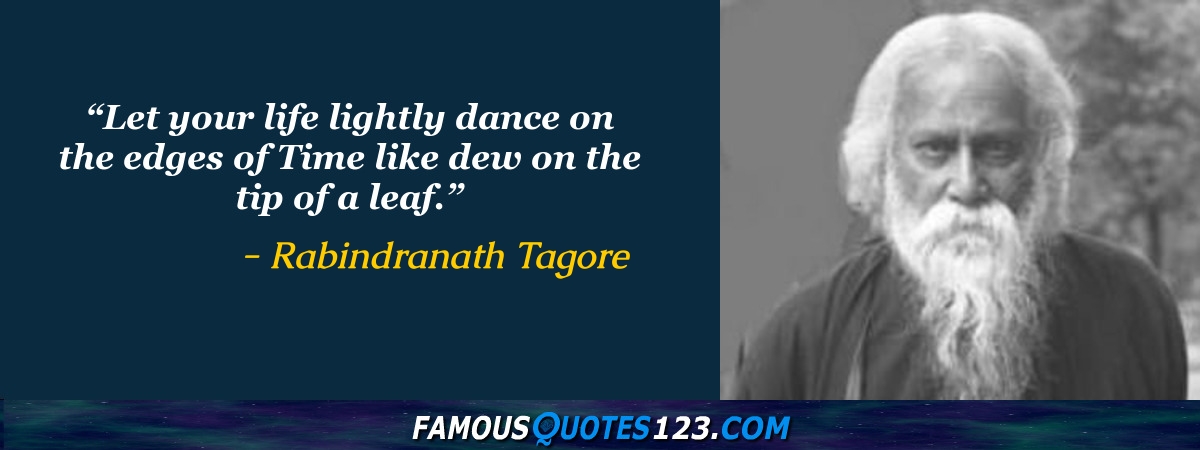
- Skip to main content
- Skip to secondary menu
- Skip to primary sidebar
- Skip to footer
A Plus Topper
Improve your Grades
Essay On Rabindranath Tagore | Essay On My Favourite Poet Rabindranath Tagore in English for Students and Children
February 12, 2024 by Veerendra
Essay on Rabindranath Tagore: The National Anthem that we sing with such pride as written by Rabindranath Tagore, who was one of the most significant men and nationalists in India. He was a poet as well as a writer and had won the Nobel Prize for his piece known as “Gitanjali.” His writings are still studied by students all over the world. We have compiled some long and short essays for the use of the readers.
You can read more Essay Writing about articles, events, people, sports, technology many more.
Long and Short Essays on Rabindranath Tagore in English Language for Kids and Children
Given below is an extended essay of approximately 400-500 words and is for the students of standards 7-10 and a short piece of nearly 100-150 words for the students of standard 1-6.
Essay On Rabindranath Tagore is for the use of students in classes 7,8,9 and 10.
Long Essay on Rabindranath Tagore in English 500 words
Rabindranath Tagore is the Bard of Bengal and is hailed as one of the most prominent Indian Poets. Tagore’s intense contribution to the world of Literature earned him the prestigious Nobel Prize in Literature. His verses and proses are considered unique in their way that the readers can relate with their day to day lives.
Tagore was born in an elite family of Calcutta and was the youngest of the thirteen siblings. He was not the brightest of student during his school life, but there was always a creative spark in him, which made formal learning difficult for him, and he detested the concept of classroom schooling.
He received great classical music lessons from professional musicians, who were sent by his father. Tagore’s family had an educational bent of mind, which made him stand out of the rest.
His phenomenal talent in portraying the real state of Bengal attracted the mass. In his stories, he tried to reflect what he saw and felt instead of writing farfetched stories. He had used his writings as a weapon to break free from the shackles of the traditional society and helped to construct a modern and logical society. His work is liked and appreciated all over the world and has been translated into innumerable languages.
“Manasi” was one of his best works, which perfectly showcased who genius a writer he was. Many of his poems were a satire to the society and was written t. o raise voice against the dominating British rule. His works portray the humble life and miseries simultaneously. His genuineness was shown by the poignancy and poise writings.
Tagore was quite vocal about his views on different political movements. He was more in support of the intellectual upliftment, and his views often conflicted with Mahatma Gandhi and other eminent political leaders. Tagore was not in favor of the Swadeshi Movement, and Globalisation was something that had a significant impact on him even during the 19th century. He was so patriotic that he had returned the Honorary Knighthood award as a protesting act against the Jallianwala Bagh Tragedy.
You can read more Famous Personalities/People’s Essay writings over here.
Tagore was credited to have written the National Anthem of India. He had also written the National Anthem of Bangladesh and Sri Lanka, Aamar Shonar Bangla, and Sri Lanka Matha, respectively. He first wrote the Sri Lanka Matha and then was translated to Sinhala by his student, Ananda Samarakoon.
The dissatisfaction of the traditional education system in England inspired him to start the “Vishwabharati University” in Santiniketan, which was initially a school that offers a friendly environment for the students to study and explore their creativity. The ending of the legend’s life was painful. He was infested by 2 elongated attacks of sickness and was affected by an exhausting disorder.
Read More: Mahatma Gandhi Essay In English 150 Words
Short Essay on Rabindranath Tagore in English 250 words
Students in classes 1, 2, 3, 4, 5 and 6 can use this Essay On Rabindranath Tagore.
Rabindranath Tagore was a great Bengali poet who had upgraded Bengali Literature in commendable ways. He was the youngest son of the leader of Brahmo Samaj, Debendranath Tagore. Rabindranath Tagore wrote the National Anthem of India and two other countries. He had written famous Dramas like Visarjan and Valmiki Pratibha. Rabindranath Tagore’s short stories are the most appreciated ones, out of which The Kabuliwala is very renowned. He received the Nobel Prize for his work “Gitanjali: the song offerings.” He passed away on 8th august 1941 when the world mourned for him.
Read More: Essay On Rabindranath Tagore
10 Lines Essay on Rabindranath Tagore in English 150 words
- Rabindranath Tagore was born in the Tagore family in Mansion of Jorasanko, Calcutta, on 7th May 1861.
- Tagore was an extraordinary writer who was determined to bring concrete changes in society.
- During the freedom struggle, his ideologies did not match with Gandhi and many famous patriots.
- He had first started the ceremony of tying the “yellow thread” to promote the idea of the fraternity during the Partition of Bengal.
- Tagore was a true patriot; he had written poems and songs, which was a powerful weapon to raise voice against the British.
- He was an incredible painter, artist, humanist, nationalist, author, rationalist, writer, philanthropist, and an eminent academician.
- He wrote the National Anthem of India, which is Jana Gana Mana, Bangladesh, which is Aamar Shonar Bangla, and Sri Lanka which is Sri Lanka Matha.
- He won the Nobel Prize in Literature in the year 1913 for his much-celebrated work, “Gitanjali: the Song Offerings.”
- He was deeply disheartened about the traditional education system, which inspired him to build up an institution unlike others, and this is how the world-famous “Viswabharati University” was formed.
- Tagore died on 8th August 1941, leaving behind his dramatic works and ideologies, which are to date studied by students all around the globe.
Frequently Asked Questions Essay On Rabindranath Tagore
Question 1. What was Rabindranath Tagore famous for?
Answer: Rabindranath Tagore was famous for his paintings, short stories, novels, and poems. Tagore was awarded the Nobel Prize in 1913 for Literature.
Question 2. In which year was Rabindranath Tagore born?
Answer: The Bard of Bengal, Rabindranath Tagore, was born on 7th May 1861, Calcutta.
Question 3. What are Rabindranath Tagore’s most famous short stories?
Answer: Some of Tagore’s most celebrated short stories are the Kabuliwala, the postmaster, etc.
- Picture Dictionary
- English Speech
- English Slogans
- English Letter Writing
- English Essay Writing
- English Textbook Answers
- Types of Certificates
- ICSE Solutions
- Selina ICSE Solutions
- ML Aggarwal Solutions
- HSSLive Plus One
- HSSLive Plus Two
- Kerala SSLC
- Distance Education
You are using an outdated browser. Please upgrade your browser to improve your experience and security.
Enhanced Page Navigation
- Rabindranath Tagore - Biographical
Rabindranath Tagore
Biographical.
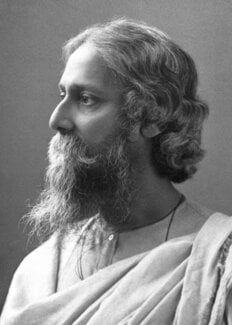
R abindranath Tagore (1861-1941) was the youngest son of Debendranath Tagore, a leader of the Brahmo Samaj, which was a new religious sect in nineteenth-century Bengal and which attempted a revival of the ultimate monistic basis of Hinduism as laid down in the Upanishads . He was educated at home; and although at seventeen he was sent to England for formal schooling, he did not finish his studies there. In his mature years, in addition to his many-sided literary activities, he managed the family estates, a project which brought him into close touch with common humanity and increased his interest in social reforms. He also started an experimental school at Shantiniketan where he tried his Upanishadic ideals of education. From time to time he participated in the Indian nationalist movement, though in his own non-sentimental and visionary way; and Gandhi, the political father of modern India, was his devoted friend. Tagore was knighted by the ruling British Government in 1915, but within a few years he resigned the honour as a protest against British policies in India.
Tagore had early success as a writer in his native Bengal. With his translations of some of his poems he became rapidly known in the West. In fact his fame attained a luminous height, taking him across continents on lecture tours and tours of friendship. For the world he became the voice of India’s spiritual heritage; and for India, especially for Bengal, he became a great living institution.
Although Tagore wrote successfully in all literary genres, he was first of all a poet. Among his fifty and odd volumes of poetry are Manasi (1890) [The Ideal One], Sonar Tari (1894) [The Golden Boat], Gitanjali (1910) [Song Offerings], Gitimalya (1914) [Wreath of Songs], and Balaka (1916) [The Flight of Cranes]. The English renderings of his poetry, which include The Gardener (1913), Fruit-Gathering (1916), and The Fugitive (1921), do not generally correspond to particular volumes in the original Bengali; and in spite of its title, Gitanjali: Song Offerings (1912), the most acclaimed of them, contains poems from other works besides its namesake. Tagore’s major plays are Raja (1910) [ The King of the Dark Chamber ], Dakghar (1912) [ The Post Office ], Achalayatan (1912) [The Immovable], Muktadhara (1922) [The Waterfall], and Raktakaravi (1926) [ Red Oleanders ]. He is the author of several volumes of short stories and a number of novels, among them Gora (1910), Ghare-Baire (1916) [ The Home and the World ], and Yogayog (1929) [Crosscurrents]. Besides these, he wrote musical dramas, dance dramas, essays of all types, travel diaries, and two autobiographies, one in his middle years and the other shortly before his death in 1941. Tagore also left numerous drawings and paintings, and songs for which he wrote the music himself.
Rabindranath Tagore died on August 7, 1941.
This autobiography/biography was written at the time of the award and first published in the book series Les Prix Nobel . It was later edited and republished in Nobel Lectures . To cite this document, always state the source as shown above.
Nobel Prizes and laureates
Nobel prizes 2023.

Explore prizes and laureates

IMAGES
COMMENTS
Rabindranath Tagore, the revered Bengali poet and polymath, left an enduring legacy through his profound literary works and became the first non-European Nobel laureate in Literature.
Rabindranath is, in the words of Dr. Radhakrishnan, ‘the greatest figure in modern R Indian Renaissance’. Early Life & Education: Rabindranath was born on May 7, 1861 at Jorasanko, Kolkata. He was the youngest son of Maharshi Debendranath Tagore and Sarada Devi. He had a great dislike for schooling of the orthodox kind.
500+ Words Essay on Rabindranath Tagore. Essay on Rabindranath Tagore: Rabindranath Tagore was a legendary Indian poet. Furthermore, he was also a great philosopher, patriot, painter, and humanist. People often made use of the word Gurudev with regard to him.
Poet, writer and humanitarian, Rabindranath Tagore was the first Indian to be awarded the Nobel Prize for Literature and he played a key role in the renaissance of modern India. Tagore is most widely known for his poetry, but he was also an accomplished author of novels, short stories, plays and articles.
500 Words Essay On Rabindranath Tagore. Rabindranath Tagore was a mesmerising poet, a patriot, a painter, an eminent philosopher, a renowned novelist, and an educationalist. He was born on the 7th of May, 1861, in Jorasanko, Calcutta, to a Bengali Brahmin family. His birthday is also celebrated as Rabindra Jayanti.
Rabindranath Tagore FRAS ( / rəˈbɪndrənɑːt tæˈɡɔːr / ⓘ; pronounced [roˈbindɾonatʰ ˈʈʰakuɾ]; [1] 7 May 1861 [2] – 7 August 1941 [3]) was an Indian poet, writer, playwright, composer, philosopher, social reformer, and painter of the Bengal Renaissance. [4] [5] [6] He reshaped Bengali literature and music as well as Indian ...
Rabindranath Tagore was a Bengali poet, novelist and painter best known for being the first non-European to be awarded the Nobel Prize for Literature in 1913 with his book Gitanjali, Song...
Rabindranath Tagore, also known as Gurudev, was a Bengali polymath who made great contribution to Indian literature, music, as well as art. He was awarded the Nobel Prize for Literature in 1913. Let's take a look at his childhood, life history, works and achievements.
Rabindranath Tagore is the Bard of Bengal and is hailed as one of the most prominent Indian Poets. Tagore’s intense contribution to the world of Literature earned him the prestigious Nobel Prize in Literature. His verses and proses are considered unique in their way that the readers can relate with their day to day lives.
Biographical. Rabindranath Tagore (1861-1941) was the youngest son of Debendranath Tagore, a leader of the Brahmo Samaj, which was a new religious sect in nineteenth-century Bengal and which attempted a revival of the ultimate monistic basis of Hinduism as laid down in the Upanishads.